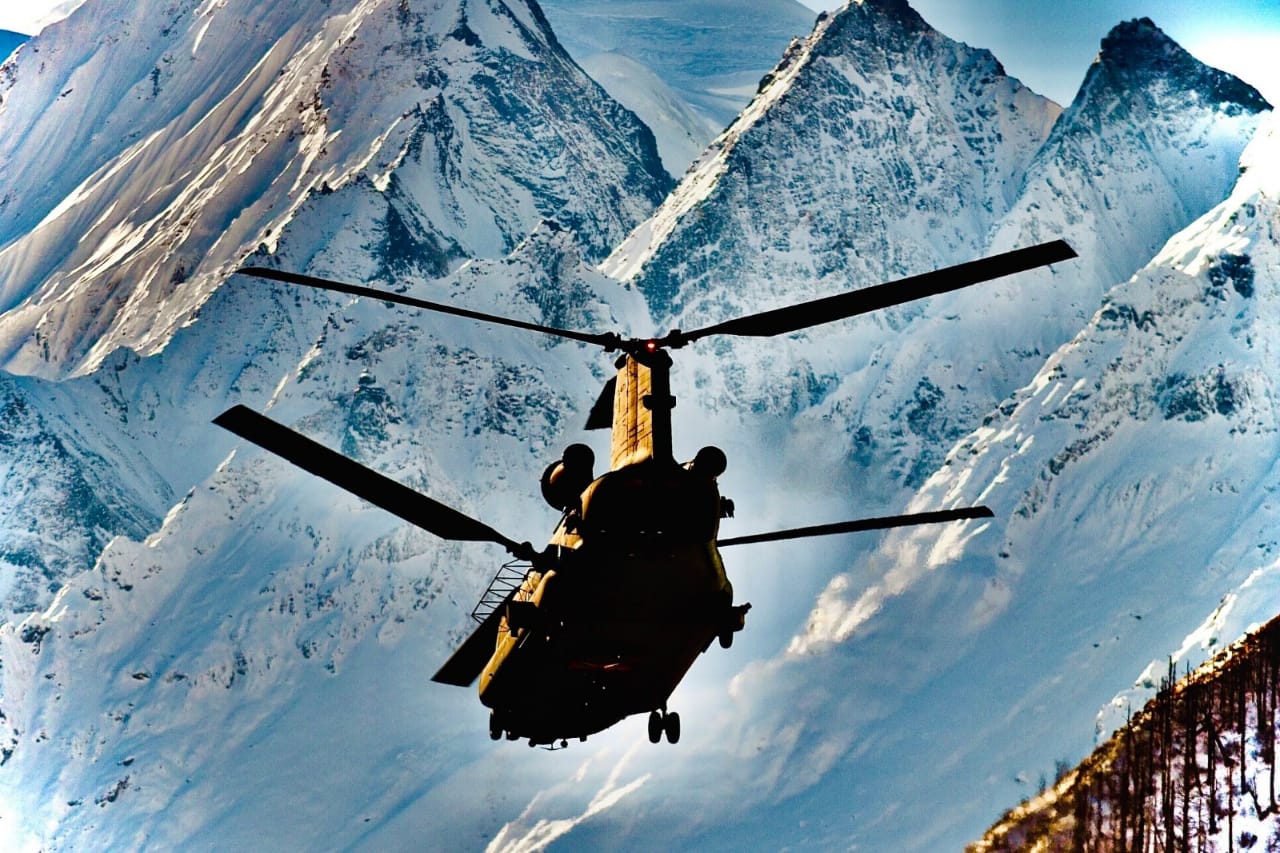Chinook ‘Roars’ In Kashmir; US-Origin Chopper Performs Maiden Landing As IAF Activates 1st Highway Airstrip In J&K

In over 75 years, Kashmir valley gets a first highway airstrip from where fighter jets can also operate. US-made Chinook helicopter did a trial landing on an emergency landing facility (ELF) stretched on a national highway in Anantnag, a hotbed of terrorism in the valley.
The landing strip is an obvious show of strength, and it gives the IAF another place to take off and land besides the Srinagar Airport and Avantipur airbase in case of hostilities. The feat was executed on the intervening nights of April 1 and 2, during the first day of the IAF’s 10-day mega exercise, ‘Gaganshakti.’
The Srinagar Airport played a crucial role in saving Jammu and Kashmir from the marauders in October 1947 as the Indian troops were air-inducted from Srinagar’s Airfield. The troops were sent after Maharaja Hari Singh signed the Instrument of Accession. The Emergency Landing Strip in Anantnag district in South Kashmir would be second.
This is the first time the IAF has conducted landing operations on a highway in Kashmir.
Sukhois participated in the exercise. They had previously participated in the aerial skirmish with Pakistan in 2019. Along with Sukhoi fighter jets, Chinook and Mi-17 helicopters also landed and took off from the airstrip.
The 3.5-kilometer-long emergency landing strip was opened for the trial run by Sukhoi Su-30MKI fighter jets amidst tight security. Mobile radars, CCTVs, and other sophisticated equipment were deployed along with the Army, paramilitary forces, and Jammu and Kashmir Police to ensure the security of the operation.
The traffic movement of load carriers was stopped on the highway from 4 am on 1 April to 7 am on 2 April. Light motor vehicles have been diverted on the old highway between Alstop and Doonipora.
The work on the emergency landing strip was started in 2020 and completed late last year as part of the program initiated by the IAF with the Ministry of Road Transport and Highways for the creation of ELFs at different locations across the country. The project cost Rs 119 crore. This ELF is stretched from km 246.200 to km 249.700 on the Jammu-Srinagar national highway.
The ELF is part of the IAF’s plan to have a network of 13 landing facilities that can be used across the country during the war. On March 19, the Indian Air Force activated an Emergency Landing Facility airstrip on a national highway in Andhra Pradesh’s Bapatla district, showcasing the high level of ‘synergy and liaison’ between the IAF and civil agencies.
The National Highways Authority of India (NHAI) constructed the 4.1 km long and 33m wide concrete airstrip according to the IAF’s specifications. During the activation, Sukhoi Su-30 and Hawk fighters successfully carried out overshoots, while An-32 and Dornier transport aircraft landed and subsequently took off from the strip.
In October 2017, IAF fighter jets and transport planes conducted mock landings on the Lucknow-Agra Expressway to demonstrate that such highways can be used by IAF planes in case of an emergency.

How Did Srinagar Airfield Save Kashmir In 1947?
In essence, the Srinagar airport’s strategic importance lay in its role as a gateway to defend Srinagar and prevent its capture during a critical phase of the conflict.
After the partition of India in 1947, Pakistan Army regulars disguised as Pashtun tribes breached the border and were pillaging and killing the local population.
The IAF carried out a daring airlift operation. Despite the airport’s limitations, they successfully transported Indian army troops to Srinagar. This timely reinforcement thwarted the Pakistani forces’ attempts to seize the city.
Post-Independence, the Budgam landings were the first military operations of India when the IAF had air-inducted elements of the First Battalion of the Sikh Regiment on Dakota transport aircraft to secure the Srinagar airfield. Their mission was twofold: secure the airfield and establish a blocking position east of Baramulla.
The IAF’s Dakotas ferried the 1st Sikh that changed the course of history. The Indian troops evicted the intruders till a ceasefire was declared on January 5, 1949.
Dakotas that served the IAF till 1988 proved to be game-changers by saving the Kashmir valley for India. They have also been credited with the liberation of Bangladesh and hastening Dhaka’s fall.
Originally known as the Douglas DC-3, the aircraft is a low-wing metal monoplane equipped with conventional landing gear and powered by two radial piston engines. It had a major and lasting effect on the airline industry in the 1930s to 1940s and on World War II.
Equipped with a cruising speed of 207 mph, the DC-3 could carry 21 to 32 passengers or 6,000 lbs of cargo and was capable of operating from short runways.
- Questions and Answers
- Opinion
- Motivational and Inspiring Story
- Technology
- Live and Let live
- Focus
- Geopolitics
- Military-Arms/Equipment
- Güvenlik
- Economy/Economic
- Beasts of Nations
- Machine Tools-The “Mother Industry”
- Art
- Causes
- Crafts
- Dance
- Drinks
- Film/Movie
- Fitness
- Food
- Oyunlar
- Gardening
- Health
- Home
- Literature
- Music
- Networking
- Other
- Party
- Religion
- Shopping
- Sports
- Theater
- Health and Wellness
- News
- Culture

